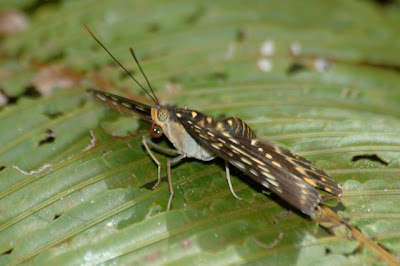 This rather peculiar angle represents the closest I could get to a female Archduke (Lexias pardalis) (or should that be Archduchess?). The Archduke is a common but fast-flying and rather shy forest butterfly. You can tell this one is a female by the spots (even on her eyes!); males are velvety black, with a broad swath of iridescent satiny blue along the edges of the hindwings. There are a number of species of Archduke; this one has its antennae tipped orange, a giveaway that this is L. pardalis and not the very similar L. dirtea, whose antennae are entirely black. It's surprising how easy this seemingly trivial difference is to see on the forest floor (and the difference probably means a great deal to butterflies in search of the right mate).
This rather peculiar angle represents the closest I could get to a female Archduke (Lexias pardalis) (or should that be Archduchess?). The Archduke is a common but fast-flying and rather shy forest butterfly. You can tell this one is a female by the spots (even on her eyes!); males are velvety black, with a broad swath of iridescent satiny blue along the edges of the hindwings. There are a number of species of Archduke; this one has its antennae tipped orange, a giveaway that this is L. pardalis and not the very similar L. dirtea, whose antennae are entirely black. It's surprising how easy this seemingly trivial difference is to see on the forest floor (and the difference probably means a great deal to butterflies in search of the right mate). This very common little butterfly is a bushbrown, a member of a very diverse group of Asian and Australasian butterflies. This species, Mycalesis patiana, doesn't appear to have an English common name.
This very common little butterfly is a bushbrown, a member of a very diverse group of Asian and Australasian butterflies. This species, Mycalesis patiana, doesn't appear to have an English common name. This little lizard crossed the boardwalk at the Frog Pond as I sat waiting for the Oriental Dwarf Kingfishers. It appears to be a Black-banded Skink (Mabuya rudis). If it is, then its cream-coloured throat marks it as a female; in males the throat is crimson. This species occurs on a number of islands in Malaysia and Indonesia, but apparently does not reach the Asian mainland.
This little lizard crossed the boardwalk at the Frog Pond as I sat waiting for the Oriental Dwarf Kingfishers. It appears to be a Black-banded Skink (Mabuya rudis). If it is, then its cream-coloured throat marks it as a female; in males the throat is crimson. This species occurs on a number of islands in Malaysia and Indonesia, but apparently does not reach the Asian mainland.
...And this is a pill millipede (Superorder Oniscomorpha). It is, in fact, the same individual you can see trundling across the banner at the top of this page. Here, it is demonstrating its chief (and perhaps only) talent: rolling up into a tight little (pill-shaped?) wheel when disturbed. In this position it is about the size of a flattened ping-pong ball. Yeo Siew Tick found this one along Kubah's waterfall trail, and it provided us with a welcome distraction during a two-hours-plus attempt to see a Blue-banded Pitta (the pitta called constantly, but never showed himself). There are numerous species of pill millipedes, belonging to two (perhaps unrelated) groups, and some species vary a lot in colour, so I am not even going to try to identify this one.
Millipedes are charming creatures, though (unlike their carnivorous relatives the centipedes, millipedes are harmless feeders on decaying vegetation, though some species protect themselves with toxic skin secretions). Giant pill millipedes like this one (and even larger ones from Madagascar) are even sold in the international pet trade. I prefer them in the wild, myself.
PS: to tell a millipede from a centipede, count the number of legs per segment. Centipedes have one pair; millipedes have two.

Just in case you were interested, your millipede is from the order Sphaerotheriida. This order has 13 segments (12 visible when rolled) and is found in Africa, Madagascar, tropical Asia, Australia, New Zealand, and Australasia.
ReplyDeleteThe other order, Glomerida, has 12 segments (11 visible when rolled) and is found in Europe, N. America, N. Africa, and parts of western Asia.
Many thanks for this information! I assume it is not possible to narrow the identification further from the photographs?
ReplyDeletehey there~
ReplyDeletei just google about pill millipede and found ur blog...sort of interesting....
I love that millipede!!! I have one at home, although not a pill millipede and they really are charming :)
ReplyDeleteDo you know any species of pill millipedes that are colourful and easy to keep as pets??Thank you